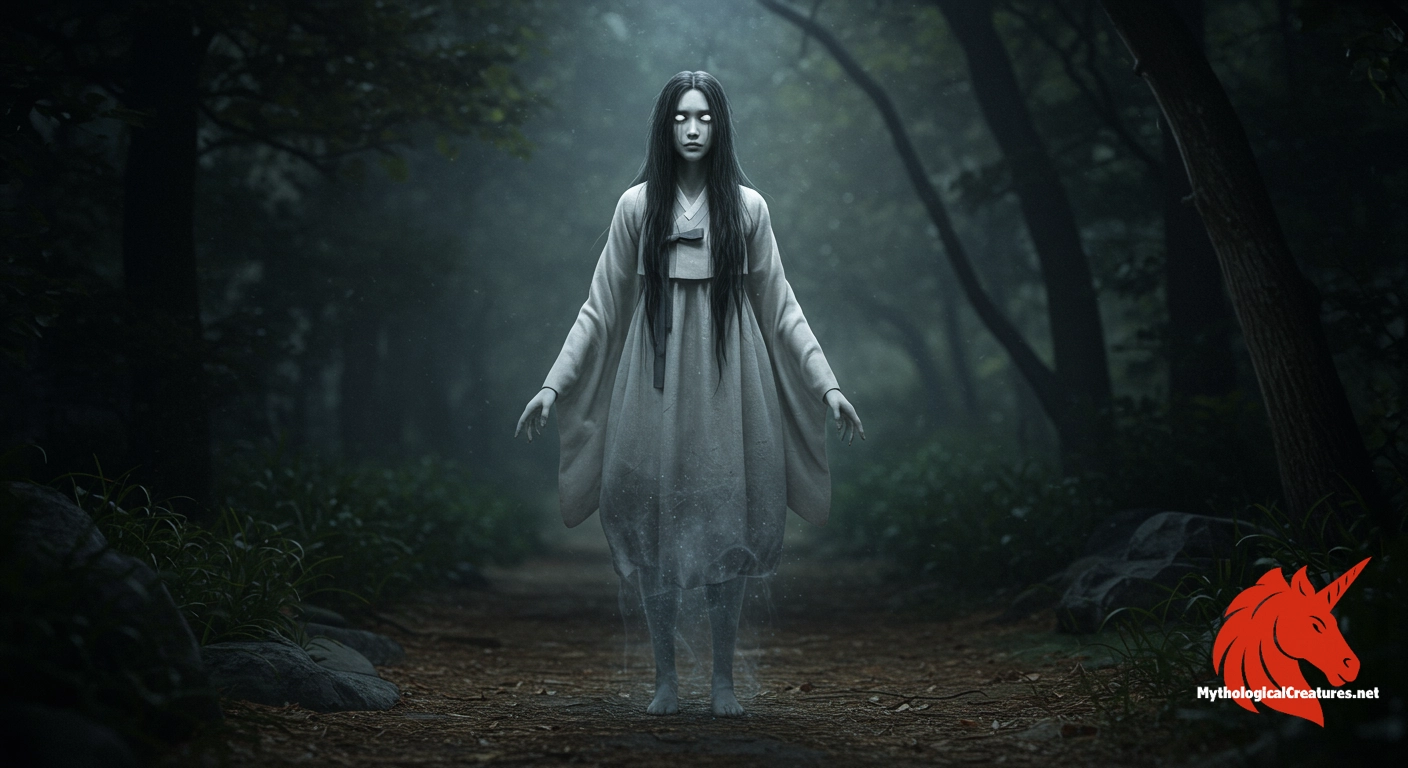Korean virgin ghost: The Korean Virgin Ghost, also known as Cheonyeogwisin, is the spirit of an unmarried woman from Korean folklore and urban legend.

Korean virgin ghost
Korean virgin ghost - Represents the tragic fate of unmarried women and societal pressures in Korean culture.
Origins & First Encounters
The Korean Virgin Ghost emerges as one of Korea’s most evocative and mysterious apparitions. She embodies the restless spirit of an unmarried woman whose untimely demise has left her wandering the threshold between life and death. Her origins are deeply entwined with a historical period when marital status was a core criterion for social acceptance, and an early death meant a life of unfulfilled promise. The narrative surrounding her reflects the emotional toll of societal neglect and the harsh repercussions faced by women who did not conform to traditional expectations. Her spectral presence has been passed down through generations, evolving from a cautionary tale into a profound symbol of personal loss and enduring sorrow.
In the realm of folklore, she is remembered not merely as a frightful presence but as a poignant reminder of lives truncated by rigid social norms. Modern retellings often imbue her character with both empathy and trepidation, inviting audiences to reconsider the historical values that once dictated her fate. Her story has gradually morphed into a multifaceted legend, resonating in both rural myth and urban legend. Even today, her legacy offers a reflective critique of past injustices, serving as a bridge between traditional narratives and contemporary cultural discourse.
Source Texts & Tale Variants
Narratives of the Korean Virgin Ghost have been preserved through an eclectic blend of ancient manuscripts, local oral histories, and modern urban legends. Traditional accounts collected from rural communities and old village records form the backbone of her early attestations. These varied sources, often transmitted by word of mouth, recount her melancholic wanderings and mysterious encounters with the living. Chroniclers and folklore enthusiasts over the centuries have contributed to a patchwork of stories, each adding distinct regional flavours and emotional nuances. The evolution of her narrative can be traced through these texts, which reflect both local traditions and the changing societal attitudes toward unmarried women.
In more recent times, urban legends and modern media have enriched her story with contemporary concerns, blending age-old superstitions with modern anxieties. Variants arise in diverse retellings, with some versions portraying her as an omen of misfortune and others as a symbol of unresolved injustice. The multiplicity of story variants continues to add depth to her character, ensuring that her myth remains both adaptable and resonant. This broad spectrum of sources exemplifies the dynamic interplay between historical record and cultural imagination, making her one of Korea’s most enduring ghostly figures.
Form & Powers
Artistic and literary renderings of the Korean Virgin Ghost consistently focus on the ethereal qualities of her presence. She is most commonly depicted wearing a flowing white hanbok or a traditional burial shroud, which symbolises both purity and the tragic incompleteness of her life. Her complexion is invariably described as pallid, lending her an otherworldly air that distances her from the realm of the living. Many accounts emphasise the long, unbound, and sometimes dishevelled nature of her hair, which appears to float about her like a spectral mist. Her eyes are often portrayed as deep and reflective, hinting at a profound sadness as if they hold centuries of unspoken lament.
Additional artistic depictions highlight subtle textures in her appearance, such as a faint translucence that blurs the line between form and essence. In some regional variations, the ghost is illustrated as being slightly smaller or even diminutive, underscoring her delicate and ephemeral nature. The blend of traditional attire with supernatural aesthetics has given rise to a consistently evocative visual narrative. Every detail in these depictions, from her forlorn expression to the billowing drapery of her garments, reinforces her identity as a figure suspended in perpetual mourning.
Regional Faces
The lore of the Korean Virgin Ghost is marked by striking regional variations, each of which offers its own interpretation of her tragic existence. Known by alternative names such as Malmyeong, Sonmalmyeong, and Songaksi in different areas, her story adapts to reflect local customs and historical experiences. In rural locales, she is often described as a solitary wanderer frequenting abandoned pavilions or ancient burial grounds, which imbues her with a sense of both isolation and timeless sadness. These local narratives infuse her tale with nuances that echo regional superstitions and collective memories of past calamities. The portrayal of her character varies significantly, with some communities emphasising her role as a benign, sorrowful presence and others depicting her as a more ominous harbinger of misfortune.
In contrast, urban legends often situate her within modern, deserted thoroughfares and forlorn alleyways, reflecting the collision of old folklore with contemporary life. Regions steeped in traditional Confucian values may stress the moral lessons inherent in her story, while more modern adaptations highlight themes of emancipation and defiance. Such diverse representations illustrate how local cultural dynamics and historical contexts continue to shape her myth. The regional adaptations not only enhance the complexity of her character but also serve as a mirror to the evolving societal attitudes across Korea.
Cultural Parallels
An intriguing parallel exists between the Korean Virgin Ghost and similar ghostly figures in other East Asian traditions. Much like the vengeful onryo in Japanese folklore or the restless female spectres found in Chinese legends, she occupies a space where personal tragedy intersects with societal expectations. These ghostly apparitions, though culturally distinct, all share underlying themes of sorrow, injustice, and the heartbreaking consequences of unfulfilled lives. The omnipresent motif of a woman whose life was cut short before the fulfilment of her destined role resonates broadly across the region, providing a common cultural thread. Such figures often serve as unwitting critics of traditional societal structures that have long dictated the course of women’s lives.
Comparative studies reveal that these spectral narratives emphasize a shared cultural critique, using supernatural elements to symbolise real-world social discontents. Both the Korean and Japanese spectres, for example, are portrayed with an air of melancholic beauty and an unyielding sense of loss. As modern media and literature continue to explore these themes, the cross-cultural similarities become ever more apparent, underscoring a broader East Asian preoccupation with honour, identity, and the afterlife. These shared mythological elements illuminate how traditional narratives have transcended cultural boundaries to inform a diverse yet interconnected folkloric landscape.
Legacy & Modern Evolution
The evolution of the Korean Virgin Ghost has mirrored the changing tides of society and the arts over many centuries. In her earliest depictions, she served as a stark symbol of the rigid social codes that dictated women’s lives, a ghostly reminder of the tragic cost of nonconformity. These traditional portrayals were steeped in moral and cautionary undertones, designed to reinforce the imperatives of social propriety. With the advent of modernity, however, her image began to transform, adapting to new narrative frameworks that question old conventions while preserving the melancholic essence of her story. Her legend thereby evolved from one of simple moral admonition into a multi-layered myth encapsulating both loss and quiet defiance.
In contemporary culture, the Korean Virgin Ghost is embraced by filmmakers, writers, and artists as a rich symbol of resistance and the enduring impact of historical prejudice. Modern interpretations often portray her with a complexity that speaks to the nuanced struggles of modern identity and the lingering presence of ancient societal norms. Her visual representations have been reimagined in cinema, graphic novels, and digital media, each medium exploring different dimensions of her character. Today, she stands not only as a relic of bygone traditions but also as a dynamic emblem in debates over modernity, gender, and cultural memory. The legacy of her tale continues to inspire both reflection and creative re-imagining, ensuring that her spirit remains as compelling and relevant as ever.
Interesting Fact
The Korean Virgin Ghost has inspired numerous films and literary works, cementing her status as one of the most enduring and culturally significant figures in Korean ghost lore.
Quick Creature Info
Origin:
Features:
Our Mythic Legendary Rating:

Also Sometimes Known As:
Habitat:
Supernatural Powers:
Physical Attributes:
Abilities:
Behavior:
Lore:
Related Creatures, Tales or Lore
- JJapanese Yūrei
- CChinese Hungry Ghost
- FFilipino White Lady
References
Discover Another Mythical Legend You May Not Have Heard Of?
Uncover the mysteries of ancient folklore and expand your knowledge of legendary beings from cultures around the world.
Dare to Meet the Skuld....
Mythical Disclaimer: The images and data on this site are derived from various historical and literary sources, but we have found that many myths often have multiple versions and interpretations across references, sometimes contradictory. As a result, these creature depictions are artistic interpretations—imaginative blends of folklore, legend, and a dash of AI guesswork. Because creature descriptions vary widely, our illustrations and accompanying information represent our best effort to honor mythology while bridging creative gaps. Enjoy these interpretations—just remember, we've done our best to respect the stories and validate available data, but in the realm of mythology, details often shift, imagination leads the way, and nothing is ever set in stone!
Curated by the Mythological Creatures Team (rev. May 2025)
